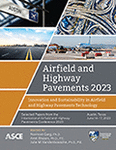Strength and Cracking Potential Relationships in Cementitiously Stabilized Pavement Layers
Publication: Airfield and Highway Pavements 2023
ABSTRACT
Chemical stabilization of marginal materials with calcium-based agents is a sustainable means to improve the engineering properties of multi-layer structures. In the stabilization process, hydration reactions form cementitious compounds creating strong interparticle bonds, which in turn lead to a more efficient load distribution capacity of the pavement foundations. Mixture design anomalies give rise to the continuous consumption of water in exothermic hydration reactions, which results in the volumetric instability and cracking of the cementitiously stabilized layers. Such cracks can potentially propagate to other layers and jeopardize the longevity and performance of the pavement structures. Therefore, it deems necessary to characterize the shrinkage cracking potential of cement-treated layers properly. Traditionally, a limiting threshold of the unconfined compressive strength test during the mixture design is defined to predict the cracking behavior of the stabilized layers. This study, however, explores practical techniques to measure the shrinkage strain in cement-treated granular materials with specific thermal cycle provisions for virgin aggregates, recycled materials, and full depth reclamation (FDR) mixtures. The main focus of this research was to study the impact of aggregate type and cement dosage on the shrinkage strain of prismatic specimens in the laboratory and to develop relationships between the volumetric strain, unconfined compressive strength, and indirect diametrical tensile strength of cement-treated marginal materials. To accomplish these objectives, a laboratory program was developed considering four different aggregate sources and three increasing levels of stabilizer dosage. The post-processed laboratory results showed the inconsistency of predictions of cracking potential using the traditional strength tests. The deviation from the expected norms was more pronounced for the FDR materials with potential contaminations of the mixes with plastic subgrade soils during the milling process. The outcome of this research can provide valuable insight into the laboratory mixture design of pavement foundations using virgin, recycled, and reclaimed materials treated with cementitious stabilizers.
Get full access to this article
View all available purchase options and get full access to this chapter.
REFERENCES
AASHTO. (2015). Standard Method of Test for Coefficient of Thermal Expansion of Hydraulic Cement Concrete. AASHTO T 336-15, American Association of State Highway and Transportation Officials.
Ashtiani, R. S., Rashidi, M., Rodriguez, E., Ordaz, M., Cruz, H., Garay, G., and Rocha, S. (2020). “Establishing Best Practices for Construction and Design of Cement Treated Materials.”, Austin, Texas.
Chompoorat, T., Thepumong, T., Khamplod, A., and Likitlersuang, S. (2022). “Improving Mechanical Properties and Shrinkage Cracking Characteristics of Soft Clay in Deep Soil Mixing.” Construction and Building Materials, 316 (2022), 125858.
Du, S. (2019). “Mechanical Properties and Shrinkage Characteristics of Cement Stabilized Macadam with Asphalt Emulsion.” Construction and Building Materials, 203 (2019), pp. 408–416.
George, K. P. (1971). “Shrinkage Cracking of Soil-Cement Base: Theoretical and Model Studies.” Highway Research Record, 351, pp. 115–133.
George, K. P. (2002). “Minimizing Cracking in Cement-Treated Materials for Improved Performance.” Research & Development Bulletin RD123, Portland Cement Association.
Jayanthi, P. N. V., and Singh, D. N. (2016). “Utilization of Sustainable Materials for Soil Stabilization: State-of-the-Art.” Advances in Civil Engineering Materials, 5(1), pp. 46–79, ASTM International.
Li, W., Lang, L., Lin, Z., Wang, Z., and Zhang, F. (2017). “Characteristics of Dry Shrinkage and Temperature Shrinkage of Cement Stabilized Steel Slag.” Construction and Building Materials, 134, pp. 540–548.
Puppala, A. J., Saride, S., and Williammee, R. (2011). “Sustainable Reuse of Limestone Quarry Fines and RAP in Pavement Base/Subbase Layers.” Journal of Materials in Civil Engineering, 24(4), pp. 418–429.
Sebesta, S. (2005). “Use of Microcracking to Reduce Shrinkage Cracking in Cement-Treated Bases.” Transportation Research Record: Journal of the Transportation Research Board, 1936, pp. 3–11.
TxDOT (Texas Department of Transportation). (2022). Test Procedure for Cement Treated Materials. TEX-120-E, Texas Department of Transportation.
Vidyashree, V. K., Mamatha, K. H., and Dinesh, S. V. (2021). “Strength Characteristics of Cement-Stabilized Recycled Asphaltic Pavement (RAP) for Pavement Applications.” Recent Trends in Civil Engineering, pp. 351–361, Springer Nature.
Wang, J. W. H. (1973). “Use of Additives and Expansive Cements for Shrinkage Crack Control in Soil-Cement: A review.” 52nd Annual Meeting of the Highway Research Board, Washington, DC.
Yoobanpot, N., Jamsawang, P., Simarat, P., Jongpradist, P., and Likitlersuang, S. (2020). “Sustainable Reuse of Dredged Sediments as Pavement Materials by Cement and Fly Ash Stabilization.” Journal of Soils and Sediments, 20 (2020), pp.3807–3823, Springer Nature.
Zhang, J., and Li, V. (2001). “Influence of Supporting Base Characteristics on Shrinkage-Induced Stresses in Concrete Pavements.” Journal of Transportation Engineering, 127(6), pp. 455–462.
Information & Authors
Information
Published In
History
Published online: Jun 13, 2023
ASCE Technical Topics:
- Cement
- Compressive strength
- Concrete
- Concrete pavements
- Continuum mechanics
- Cracking
- Engineering materials (by type)
- Engineering mechanics
- Fracture mechanics
- Infrastructure
- Material mechanics
- Material properties
- Materials characterization
- Materials engineering
- Mixtures
- Pavements
- Recycling
- Solid mechanics
- Strength of materials
- Transportation engineering
Authors
Metrics & Citations
Metrics
Citations
Download citation
If you have the appropriate software installed, you can download article citation data to the citation manager of your choice. Simply select your manager software from the list below and click Download.
